CFD Evaluation of Heat Transfer and NOx Emissions When Converting a Tangentially Fired Coal Boiler to Use Methane
Abstract
:1. Introduction
2. Computational Methods
2.1. Boiler Geometry and Mesh
2.2. Calculation Models
2.2.1. General Models
2.2.2. Convective Heat Transfer for Tube Bundles
2.2.3. Radiative Heat Transfer on Tube Bundles
2.2.4. NOx Formation and Reduction
2.3. Operating Conditions during Simulation
3. Results and Discussion
3.1. Simulation and Validation of the Coal-Fired Boiler
3.2. Comparison of Coal and Gas Firing in the Boiler
3.3. Effect of BZSR on NOx Emissions and Heat Transfer
4. Conclusions
- The good agreement between the simulated results and the measured values indicated that the simulation method is capable of predicting the boiler performance. It was proved that this boiler model can evaluate heat transfer profile and NOx emission characteristics in consideration of not only fuel properties but also operating conditions.
- Converting the boiler to run on methane increased the average gas temperature at the top of the furnace; the local maximum temperature also increased by 200–400 K. However, the low emissivity of the methane flame increased heat absorption in the tube bundles in the convection pass, at the expense of lowering heat absorption in the waterwall.
- Increasing the BZSR logarithmically increased the waterwall heat absorption, but NOx emissions increased exponentially. Even at a BZSR of 0.91, considerable differences remained compared with the heat transfer profile of the existing coal-fired boiler. It is unlikely that these differences could be rectified solely by adjusting the air distribution. Therefore, additional alternatives to reduce the FEGT would be required to implement gas firing in Boryeong Unit 3.
Author Contributions
Funding
Institutional Review Board Statement
Informed Consent Statement
Conflicts of Interest
References
- Wang, Y.; Lou, S.; Wu, Y. Coordinated planning of transmission expansion and coal-fired power plants flexibility retrofits to accommodate the high penetration of wind power. IET Gener. Transm. Distrib. 2019, 13, 4702–4711. [Google Scholar] [CrossRef]
- Pronobis, M. Chapter 10—Increasing flexibility of boiler operation. In Environmentally Oriented Modernization of Power Boilers, 1st ed.; Pronobis, M., Ed.; Elsevier: Amsterdam, The Netherlands, 2020; pp. 291–307. [Google Scholar]
- Pescia, D. Flexibility in Thermal Power Plants—With a Focus on Existing Coal-Fired Power Plants; Agora Energiewende: Berlin, Germany, 2017. [Google Scholar]
- Kumar, S.; Kwon, H.-T.; Choi, K.-H.; Cho, J.-H.; Lim, W.; Moon, I. Current status and future projections of LNG demand and supplies: A global prospective. Energy Policy 2011, 39, 4097–4104. [Google Scholar] [CrossRef]
- Lin, J.; Mou, D. Analysis of the optimal spatial distribution of natural gas under ‘transition from coal to gas’ in China. Resour. Energy. Econ. 2021, 66, 101259. [Google Scholar] [CrossRef]
- Alvarez, R.A.; Paranhos, E. Air Pollution Issues Associated with Natural Gas and oil Operations. EM: Air and Waste Management Associations’ Magazine for Environmental Managers. 2012, pp. 22–25. Available online: http://citeseerx.ist.psu.edu/viewdoc/download?doi=10.1.1.699.2532&rep=rep1&type=pdf (accessed on 22 November 2021).
- Cascio, E.L.; Borelli, D.; Devia, F.; Schenone, C. Key performance indicators for integrated natural gas pressure reduction stations with energy recovery. Energy Convers. Manag. 2018, 164, 219–229. [Google Scholar] [CrossRef]
- Li, C.; Zheng, S.; Li, J.; Zeng, Z. Optimal design and thermo-economic analysis of an integrated power generation system in natural gas pressure reduction stations. Energy Convers. Manag. 2019, 200, 112079. [Google Scholar] [CrossRef]
- IEA. Word Energy Outlook. 2021. Available online: https://www.iea.org/reports/world-energy-outlook-2021 (accessed on 19 November 2021).
- Gonzalez-Salazar, M.A.; Kirsten, T.; Prchlik, L. Review of the operational flexibility and emissions of gas- and coal-fired power plants in a future with growing renewables. Renew. Sustain. Energy Rev. 2018, 82, 1497–1513. [Google Scholar] [CrossRef]
- Binkiewicz, F.J.; Kleisley, R.J.; McMahon, B.E.; Monacelli, J.E.; Roth, D.A.; Wong, D.K. Natural Gas Conversions of Existing Coal-Fired Boilers; White Paper MS-14, Babcock & Wilcox Power Generation Group, Inc.: Barberton, OH, USA, 2011. [Google Scholar]
- Salovaara, J. Coal to Natural Gas Fuel Switching and CO2 Emissions Reduction. Ph.D. Thesis, Harvard College, Cambridge, MA, USA, 2011. [Google Scholar]
- Deng, J.; Wang, X.; Wei, Z.; Wang, L.; Wang, C.; Chen, Z. A review of NOx and SOx emission reduction technologies for marine diesel engines and the potential evaluation of liquefied natural gas fueled vessels. Sci. Total Environ. 2021, 766, 144319. [Google Scholar] [CrossRef]
- Kim, K.-M.; Kim, G.-B.; Lee, B.-H.; Jeon, C.-H.; Keum, J.-H. Methane gas cofiring effects on combustion and NOx emission in 550 MW tangentially fired pulverized-coal boiler. ACS Omega 2021, 6, 31132–31146. [Google Scholar] [CrossRef]
- Dusatko, G. Gas Cofiring Assessment for Coal Fired Utility Boilers; Technical Report for Electric Power Research Institute: Chicago, IL, USA, 2000. [Google Scholar]
- U.S. Energy Information Administration. Capital Cost and Performance Characteristic Estimates for Utility Scale Electric Power Generating Technologies; U.S. Department of Energy: Washington, DC, USA, 2020.
- Han, Y.; Shen, B.; Zhang, T. A techno-economic assessment of fuel switching options of addressing environmental challenges of coal-fired industrial boiler: An analytical work for China. Energy Procedia 2017, 142, 3083–3087. [Google Scholar] [CrossRef]
- Mills, S. Combining Solar Power with Coal-Fired Power Plants, or Cofiring Natural Gas; Report by IEA Clean Coal Centre: London, UK, 2017. [Google Scholar]
- Bedilion, R. Technology considerations for coal-to-natural gas conversions. In Proceedings of the EIA Energy Conference, Washington, DC, USA, 26–27 June 2017. [Google Scholar]
- Black, S.; Bielunis, D. Challenges when converting coal-fired boilers to natural gas. In Proceedings of the CIBO Industrial Emissions Control Technology Conference & Natural Gas Conversion Workshop, Portland, ME, USA, 5–8 August 2013. [Google Scholar]
- Pronobis, M. Chapter 6—Replacing coal with other fuels. In Environmentally Oriented Modernization of Power Boilers, 1st ed.; Pronobis, M., Ed.; Elsevier: Amsterdam, The Netherlands, 2020; pp. 167–176. [Google Scholar]
- ANSYS. Fluent Theory Guide 19.2; ANSYS, Inc.: Canonsburg, PA, USA, 2018. [Google Scholar]
- Shih, T.-H.; Liou, W.W.; Shabbir, A.; Yang, Z.; Zhu, J. A new k-ϵ eddy viscosity model for high Reynolds number turbulent flows. Comput. Fluids 1995, 24, 227–238. [Google Scholar] [CrossRef]
- Baum, M.M.; Street, P.J. Predicting the Combustion Behavior of Coal Particles. Combust. Sci. Technol. 1971, 3, 231–243. [Google Scholar] [CrossRef]
- Field, M.A. Rate of Combustion of Size-Graded Fractions of Char from a Low Rank Coal between 1200 K–2000 K. Combust. Flame 1969, 13, 237–252. [Google Scholar] [CrossRef]
- Magnussen, B.F. On the Structure of Turbulence and a Generalized Eddy Dissipation Concept for Chemical Reaction in Turbulent Flow. In Proceedings of the Nineteenth AIAA Meeting, St. Louis, MO, USA, 12–15 January 1981. [Google Scholar]
- Kim, J.P.; Schnell, U.; Scheffknecht, G. Comparison of different global reaction mechanisms for mild combustion of natural gas. Combust. Sci. Technol. 2008, 180, 565–592. [Google Scholar] [CrossRef]
- Howard, J.B.; Williams, G.C.; Fine, D.H. Kinetics of carbon monoxide oxidation in postflame gases. Symp. Int. Combust. 1973, 14, 975–986. [Google Scholar] [CrossRef]
- Pasternak, I.S.; Gauvin, W.H. Turbulent heat and mass transfer from stationary particles. Can. J. Chem. Eng. 1960, 38, 35–42. [Google Scholar] [CrossRef]
- Gnielinski, V. Berechnung mittlerer Wärme- und Stoffübergangskoeffizienten an laminar und turbulent überströmten Einzelkörpern mit Hilfe einer einheitlichen Gleichung. Forsch. Ing. 1975, 41, 145–153. [Google Scholar] [CrossRef]
- Gnielinski, V. Heat transfer in cross-flow around single rows of tubes and through tube bundles. In VDI Heat Atlas, 2nd ed.; Stephan, P., Ed.; Springer: Berlin/Heidelberg, Germany, 2010; pp. 725–729. [Google Scholar]
- Wang, H.; Zhang, C.; Liu, X. Heat transfer calculation methods in three-dimensional CFD model for pulverized coal-fired boilers. Appl. Therm. Eng. 2020, 166, 114633. [Google Scholar] [CrossRef]
- Johnson, T.R.; Bee’r, J.M. The zone method analysis of radiant heat transfer: A model for luminous radiation. J. Inst. Fuel 1973, 46, 301–309. [Google Scholar]
- Biermann, P.; Vortmeyer, D. Wärmestrahlung staubhaltiger Gase. Wärme-Und Stoffübertragung 1969, 2, 193–202. [Google Scholar] [CrossRef]
- Vortmeyer, D.; Kabelac, S. Gas radiation: Radiation from gas mixtures. In VDI Heat Atlas, 2nd ed.; Stephan, P., Ed.; Springer: Berlin/Heidelberg, Germany, 2010; pp. 979–988. [Google Scholar]
- Hill, S.C.; Douglas Smoot, L. Modeling of nitrogen oxides formation and destruction in combustion systems. Prog. Energy Combust. 2000, 26, 417–458. [Google Scholar] [CrossRef]
- De Soete, G.G. Overall reaction rates of NO and N2 formation from fuel nitrogen. Symp. Int. Combust. 1975, 15, 1093–1102. [Google Scholar] [CrossRef]
- Levy, J.M.; Chan, L.K.; Sarofim, A.F.; Beér, J.M. NO/char reactions at pulverized coal flame conditions. Symp. Int. Combust. 1981, 18, 111–120. [Google Scholar] [CrossRef]
- Kandamby, N.; Lazopoulos, G.; Lockwood, F.C.; Perera, A.; Vigevano, L. Mathematical modeling of NOx emission reduction by the use of reburn technology in utility boilers. In Proceedings of the ASME International Joint Power Generation Conference and Exhibition, Houston, TX, USA, 14–16 October 1996. [Google Scholar]


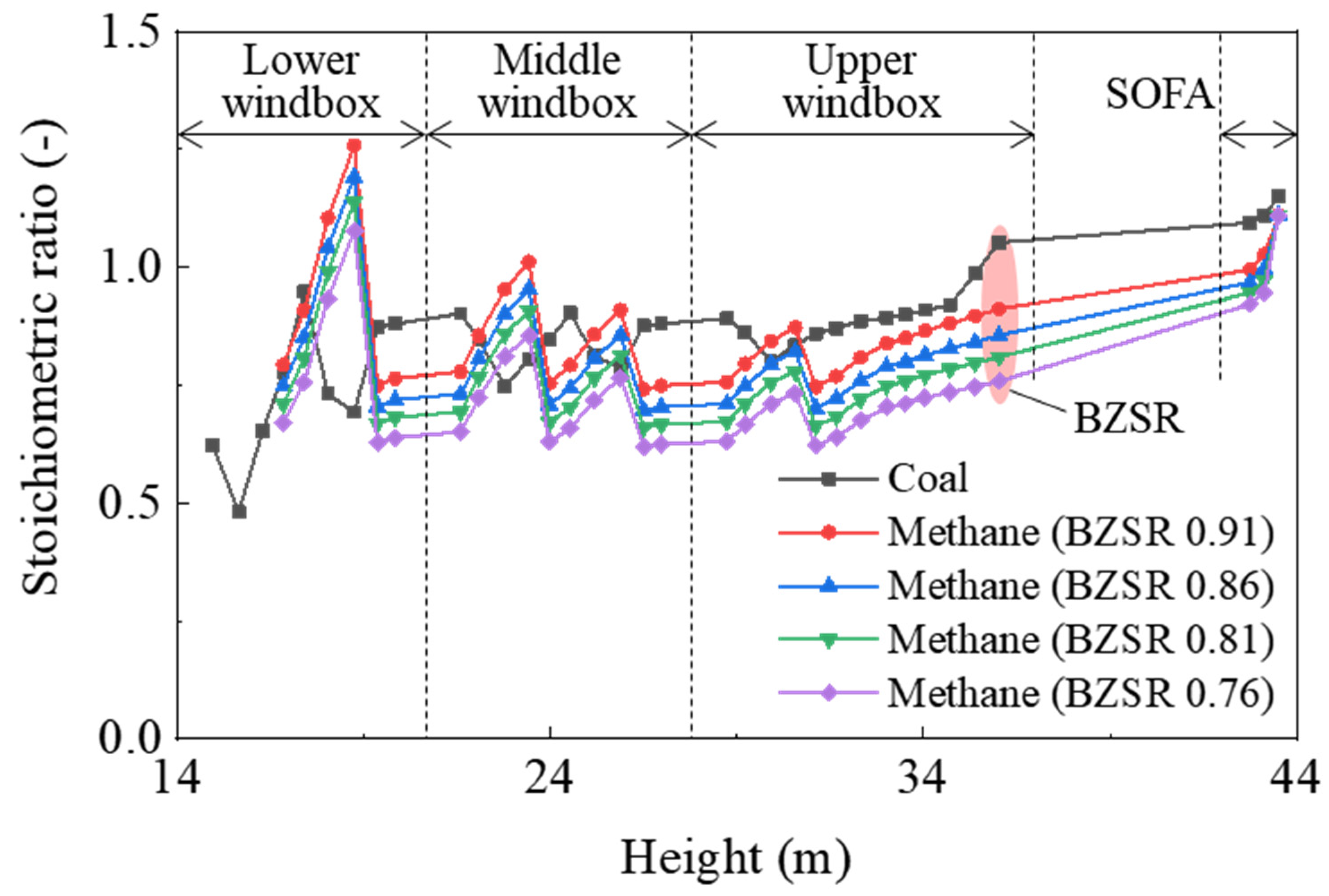
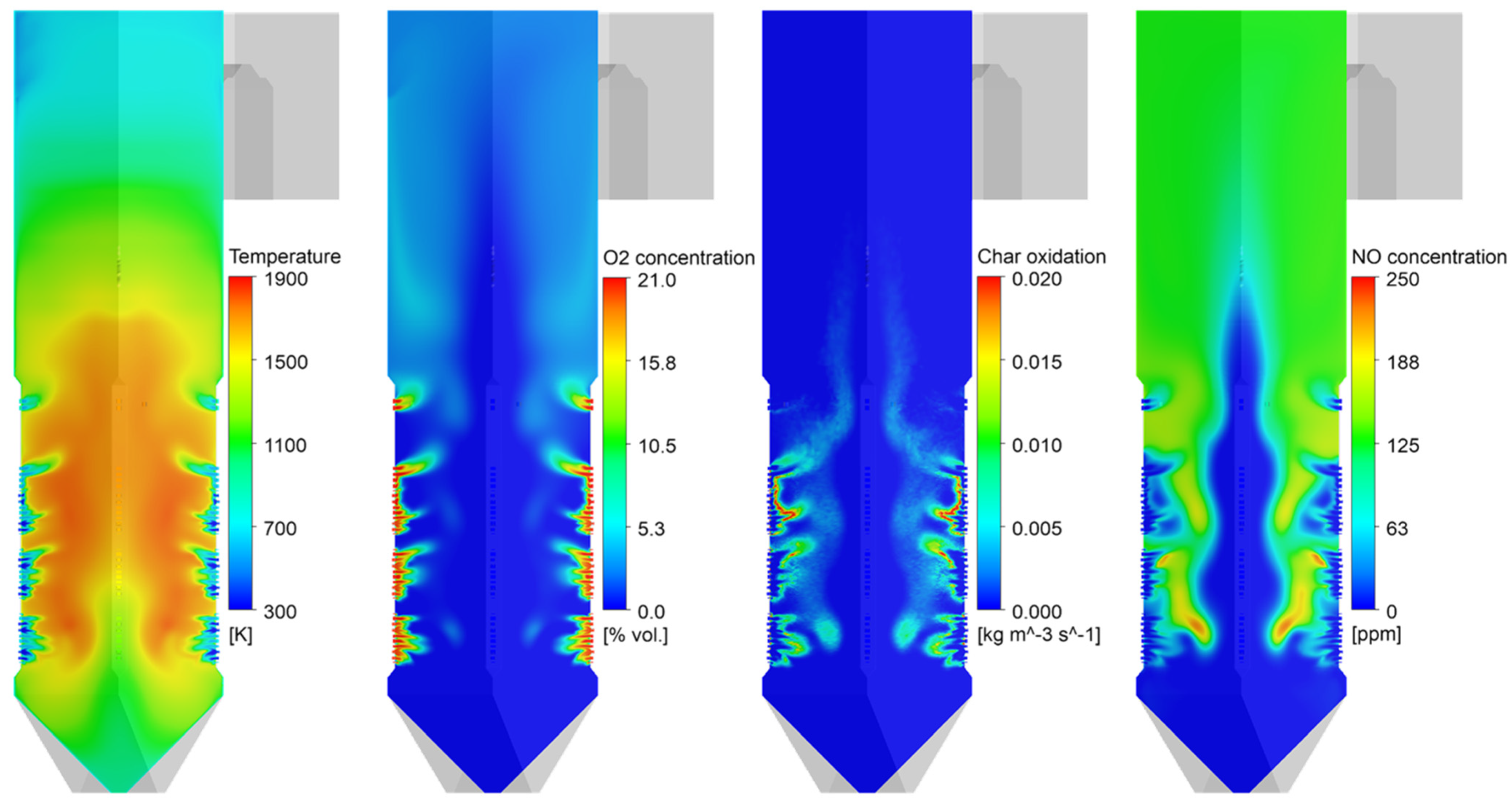

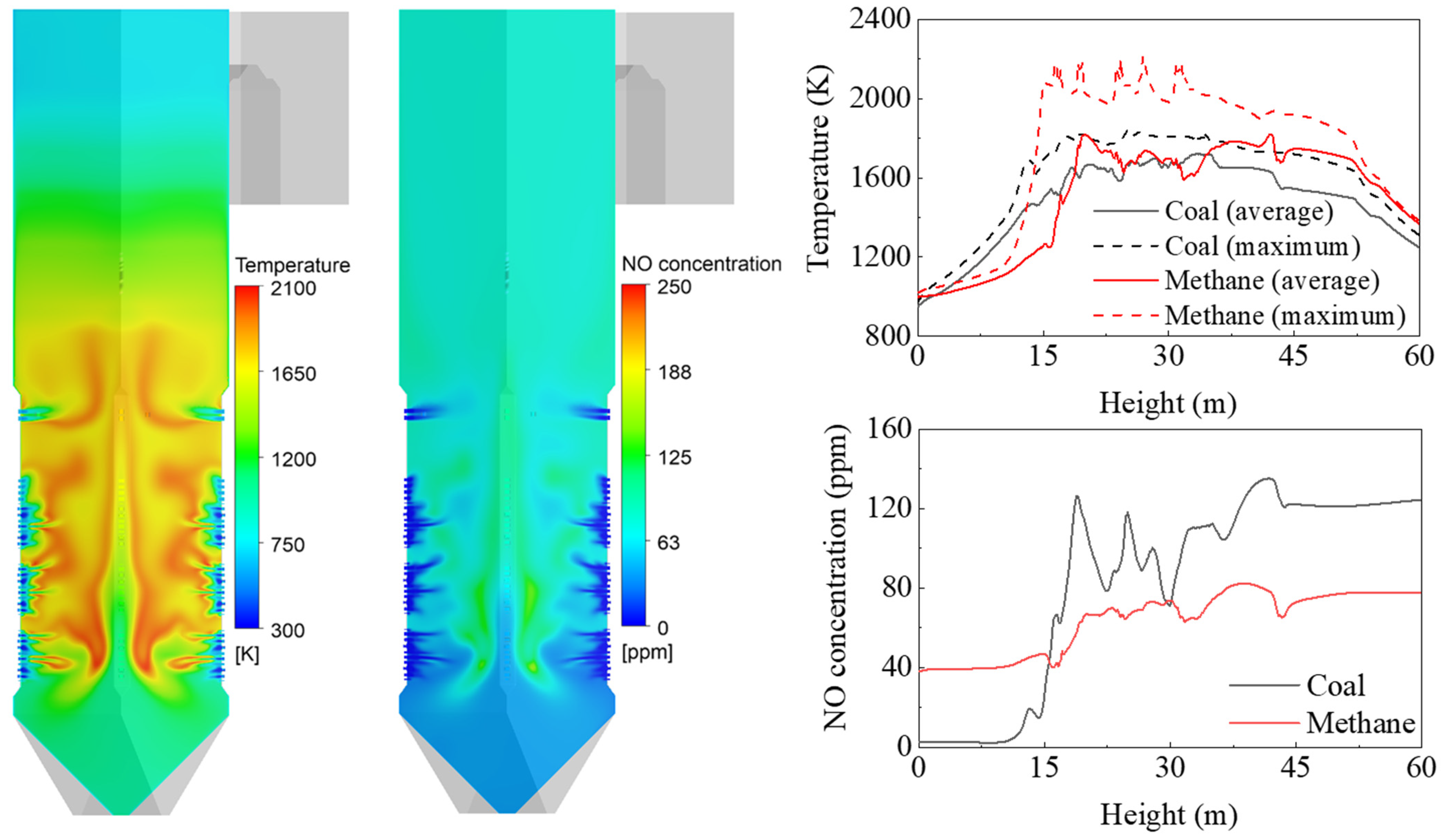
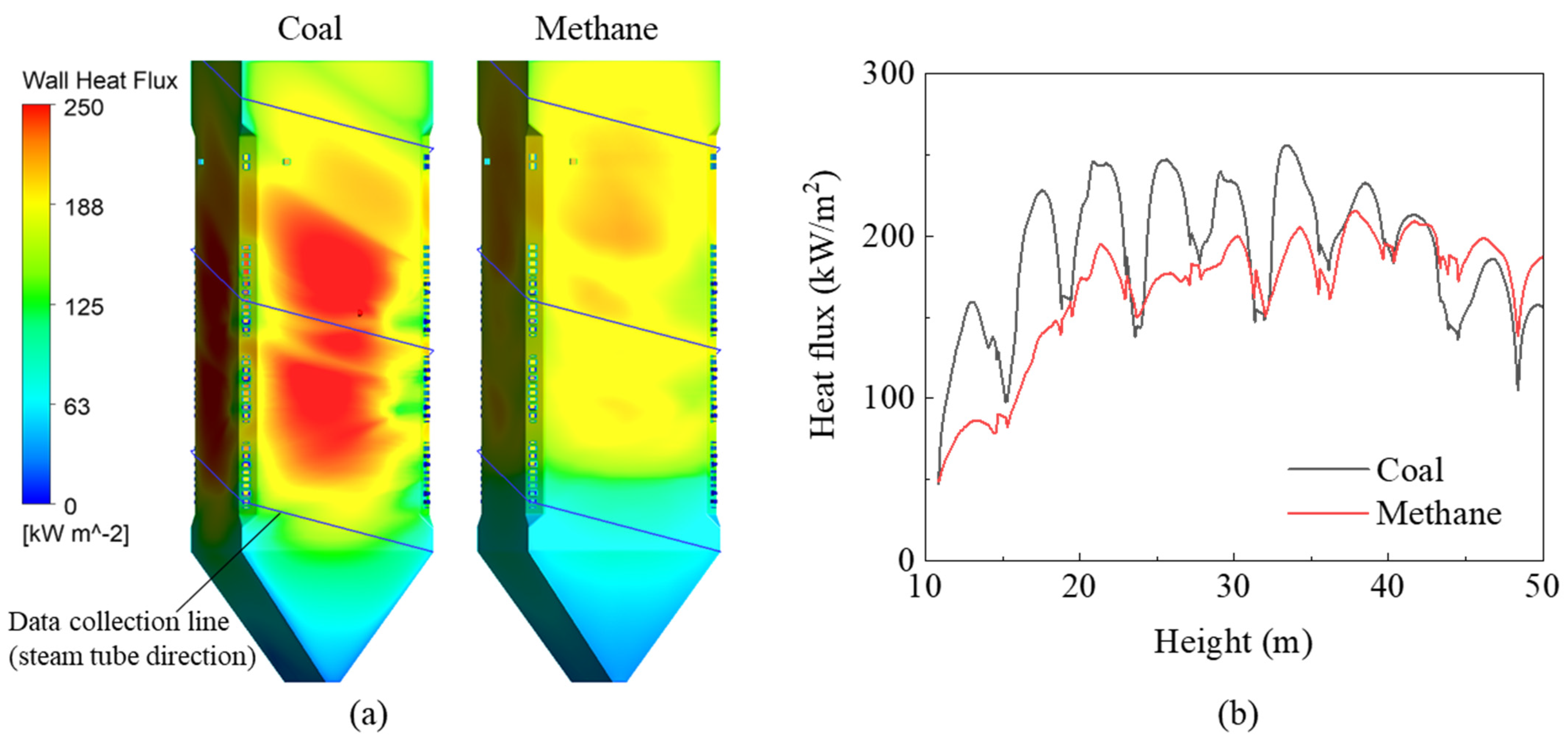
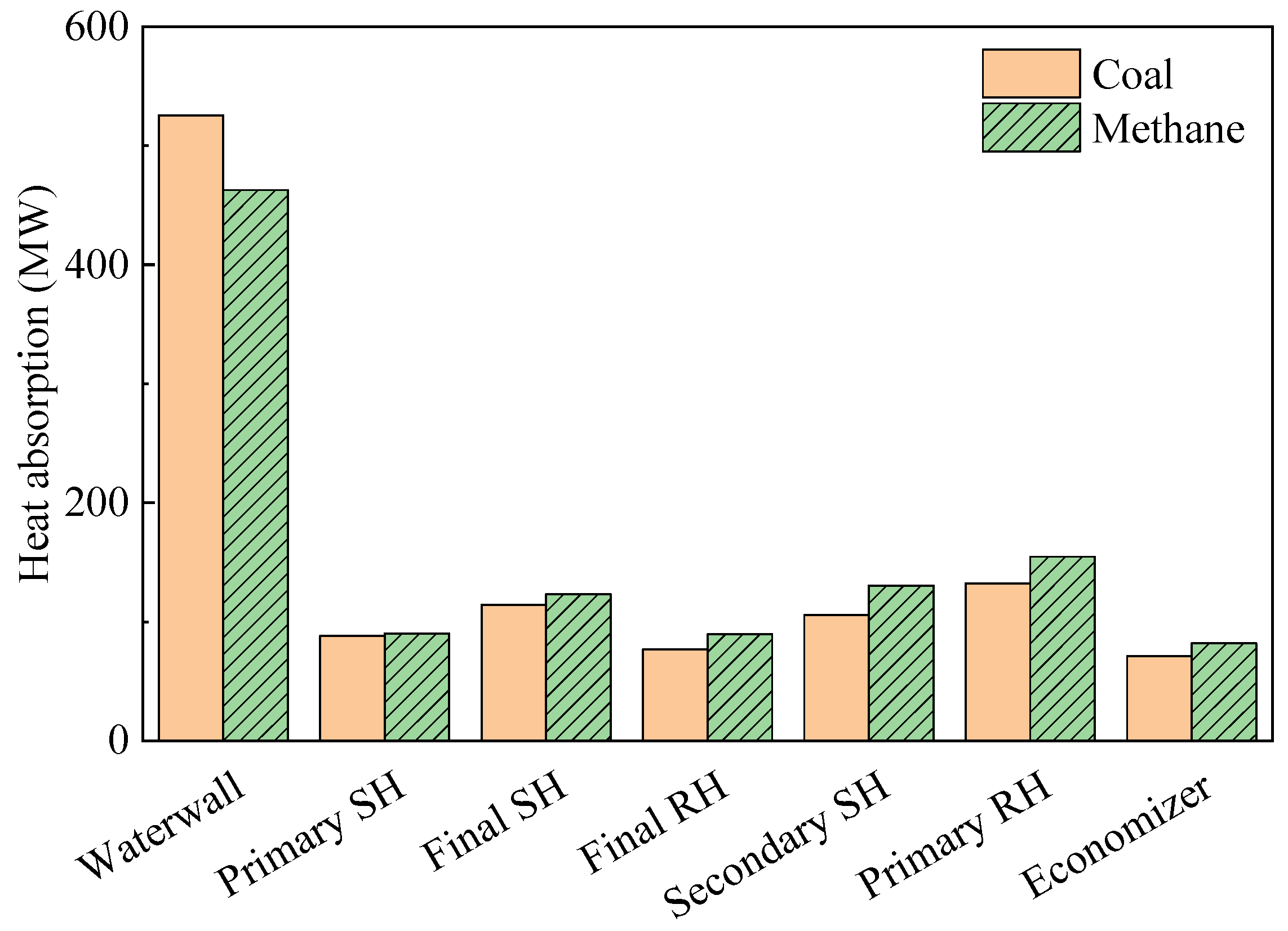
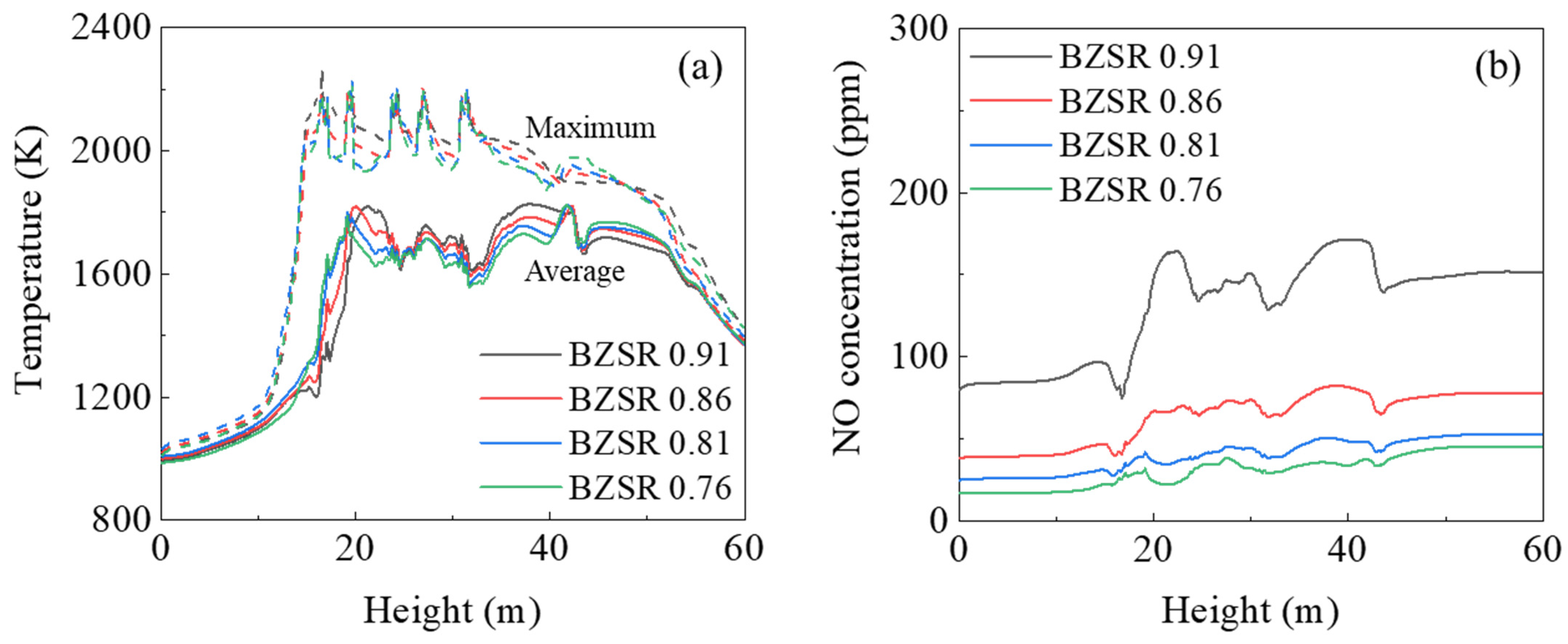


| Reaction | Rate Equation | Rate constant |
|---|---|---|
| Volatile and methane gases combustion [27] | ||
| (forward) | ||
| (forward) | ||
| Carbon monoxide combustion [28] | ||
| 1 | 0.130 | 0.265 | 0 |
| 2 | 0.595 | −0.150 | 0.824 |
| 3 | 0.275 | −0.115 | 25.91 |
| Reaction | Rate Equation | Rate Constant |
|---|---|---|
| Thermal NOx [36] | ||
| Fuel NOx [37] | ||
| NOx reduction on char surface [38] | ||
| NOx reduction by hydrocarbon radicals [39] | ||
| Gas Temperature (K) | Unburned Carbon (%) | NOx (ppm, 6% O2) | |
|---|---|---|---|
| Boryeong unit 3 | 625 | 5.22 | 119 |
| CFD | 616 | 6.67 | 123 |
Publisher’s Note: MDPI stays neutral with regard to jurisdictional claims in published maps and institutional affiliations. |
© 2021 by the authors. Licensee MDPI, Basel, Switzerland. This article is an open access article distributed under the terms and conditions of the Creative Commons Attribution (CC BY) license (https://creativecommons.org/licenses/by/4.0/).
Share and Cite
Kim, K.-M.; Kim, G.-B.; Lee, B.-H.; Bae, Y.-H.; Jeon, C.-H. CFD Evaluation of Heat Transfer and NOx Emissions When Converting a Tangentially Fired Coal Boiler to Use Methane. Energies 2022, 15, 246. https://doi.org/10.3390/en15010246
Kim K-M, Kim G-B, Lee B-H, Bae Y-H, Jeon C-H. CFD Evaluation of Heat Transfer and NOx Emissions When Converting a Tangentially Fired Coal Boiler to Use Methane. Energies. 2022; 15(1):246. https://doi.org/10.3390/en15010246
Chicago/Turabian StyleKim, Kang-Min, Gyu-Bo Kim, Byoung-Hwa Lee, Yoon-Ho Bae, and Chung-Hwan Jeon. 2022. "CFD Evaluation of Heat Transfer and NOx Emissions When Converting a Tangentially Fired Coal Boiler to Use Methane" Energies 15, no. 1: 246. https://doi.org/10.3390/en15010246






